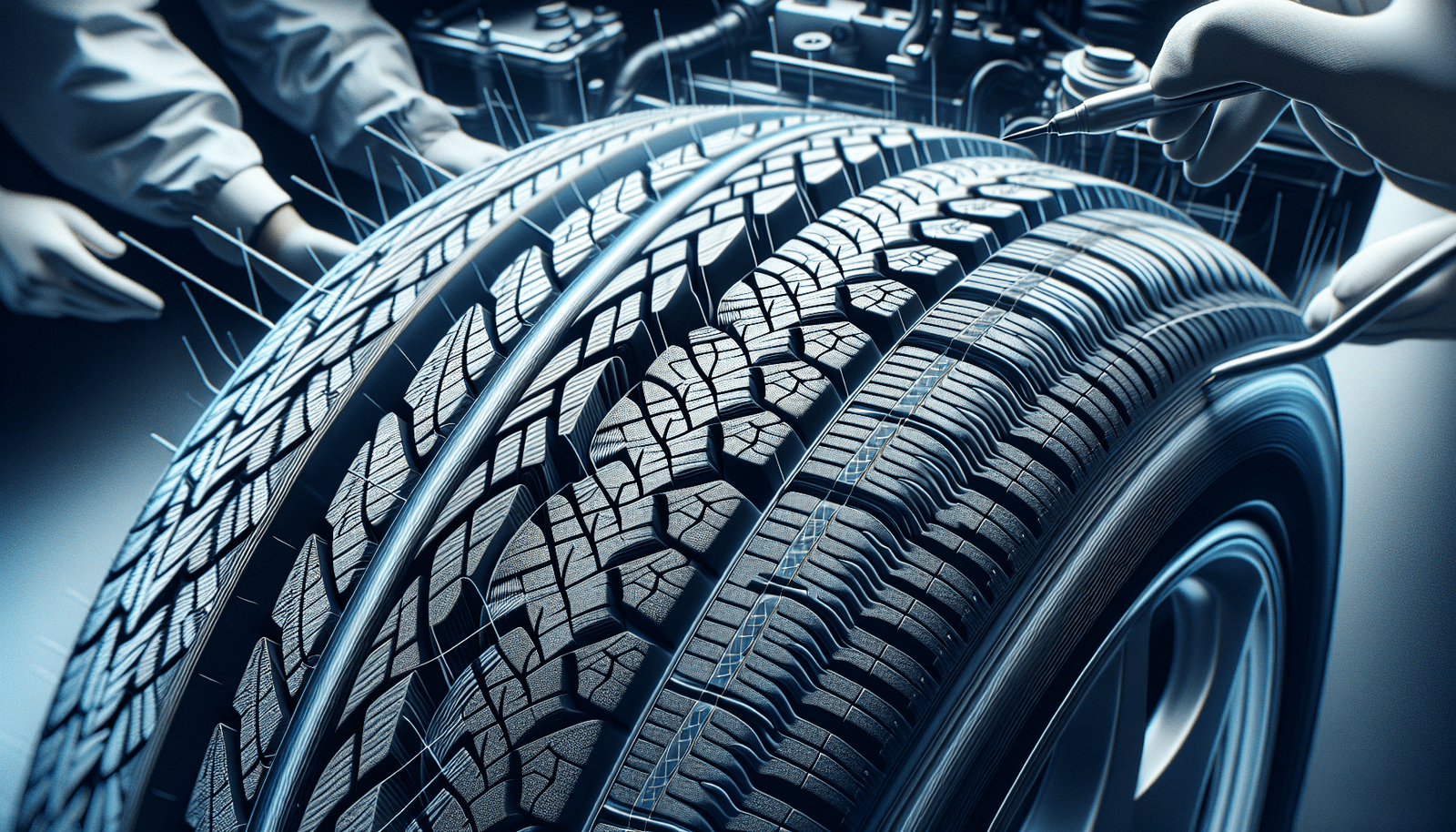Welcome to the ultimate guide on top tire rotation techniques! In this article, you will discover the importance of tire rotation and wheel alignment for extending the lifeline of your tires, ensuring a smooth ride, and improving fuel efficiency. You will learn the best practices for rotating your tires to ensure even wear and maximize their performance. So, grab a cup of coffee, sit back, and let’s dive into some valuable tips and tricks for maintaining your vehicle’s tires! Have you ever wondered how to properly rotate your tires to ensure maximum lifespan and performance? In this guide, we will walk you through the top tire rotation techniques and wheel alignment tips to keep your vehicle running smoothly. Let’s dive in and explore the best practices for maintaining your tires and wheels.
Why is Tire Rotation Important?
Tire rotation is a crucial aspect of tire maintenance that is often overlooked by many vehicle owners. By rotating your tires regularly, you can ensure even wear on all four tires, extending their lifespan and improving overall performance. Uneven wear on tires can lead to issues such as poor traction, reduced fuel efficiency, and even unsafe driving conditions. By following the proper tire rotation techniques, you can save money in the long run by avoiding premature tire replacements.
Tip: Check your vehicle’s owner’s manual for recommended tire rotation intervals and patterns.
Knowing the manufacturer’s recommendations for tire rotation intervals and patterns is essential for maintaining your tires properly. Refer to your vehicle’s owner’s manual to determine how often you should rotate your tires and which rotation pattern to follow. Following these guidelines will help you maximize the lifespan of your tires and ensure optimal performance.
When Should You Rotate Your Tires?
The frequency of tire rotation depends on several factors, including your driving habits, road conditions, and the type of vehicle you drive. As a general rule of thumb, it is recommended to rotate your tires every 5,000 to 7,500 miles or as specified in your owner’s manual. However, if you notice uneven wear on your tires or experience vibrations while driving, it may be a sign that you need to rotate your tires sooner.
Tip: Rotate your tires during every oil change as a convenient way to ensure regular maintenance.
One easy way to remember to rotate your tires regularly is to do so during every oil change. By combining these routine maintenance tasks, you can ensure that your tires are rotated at the recommended intervals without having to keep track of mileage. This simple strategy can help you stay on top of tire maintenance and prolong the lifespan of your tires.
Different Tire Rotation Patterns
There are several tire rotation patterns that are commonly used, depending on whether your vehicle is front-wheel drive, rear-wheel drive, or all-wheel drive. Each rotation pattern is designed to ensure even wear on all four tires and can help optimize performance and safety. Here are some of the most common tire rotation patterns:
Front-to-Rear (Forward Cross)
This rotation pattern is ideal for front-wheel drive vehicles and involves moving the front tires straight back and crossing the rear tires to the front. By rotating the tires in this manner, you can ensure that the wear is distributed evenly on the front and rear tires, extending their lifespan.
Side-to-Side (Lateral)
Side-to-side rotation is typically used for vehicles with different sized tires on the front and rear axles, such as performance vehicles. This pattern involves switching the front left tire with the rear left tire and the front right tire with the rear right tire. By rotating the tires in this way, you can even out wear between the front and rear tires.
Five Tire Rotation (Spare Included)
Some vehicles come equipped with a spare tire, which can be included in the rotation pattern to ensure even wear on all five tires. In this rotation pattern, the spare tire is rotated in with the other four tires to maintain consistent wear across all tires. This method is especially useful for vehicles with full-size spare tires.
Tip: Consult a professional mechanic or tire specialist for guidance on the best rotation pattern for your vehicle.
If you are unsure about the best rotation pattern for your specific vehicle, it’s always a good idea to seek advice from a professional mechanic or tire specialist. They can recommend the most suitable rotation pattern based on your vehicle’s layout and driving habits. Consulting an expert can help you make informed decisions about tire rotation and ensure that your tires are properly maintained.
DIY Tire Rotation Steps
If you prefer to rotate your tires at home, you can follow these simple steps to perform a basic tire rotation on your vehicle. Keep in mind that some vehicles may require specialized tools or equipment for tire rotation, so it’s essential to check your owner’s manual for specific recommendations before attempting to rotate your tires.
- Position your vehicle: Park your vehicle on a flat surface and engage the parking brake to ensure stability during tire rotation.
- Loosen lug nuts: Use a lug wrench to loosen the lug nuts on all four tires, but do not remove them completely.
- Raise the vehicle: Utilize a jack to lift the vehicle off the ground, ensuring that it is securely supported by jack stands.
- Remove the wheels: Once the vehicle is safely raised, remove the lug nuts and take off each wheel, ensuring they are placed in a safe location.
- Rotate the tires: Follow the recommended rotation pattern for your vehicle type, ensuring that the tires are placed in the correct positions.
- Reinstall the wheels: Securely tighten the lug nuts on each wheel, following a star pattern to ensure uniform pressure.
- Lower the vehicle: Carefully lower the vehicle back to the ground and remove the jack stands before driving.
Tip: Keep track of the rotation pattern and mileage for future reference.
To ensure that you rotate your tires at the recommended intervals and in the correct pattern, it’s helpful to keep a record of the rotation pattern used and the mileage at the time of rotation. Keeping track of this information can help you stay on schedule with tire maintenance and prevent uneven wear on your tires.
Importance of Wheel Alignment
In addition to tire rotation, wheel alignment is another critical aspect of maintaining your vehicle’s tires and overall performance. Proper wheel alignment ensures that your tires make consistent contact with the road surface, reducing wear and optimizing handling. Misaligned wheels can lead to uneven tire wear, decreased fuel efficiency, and even steering issues. Regular wheel alignment checks can help you avoid these problems and extend the lifespan of your tires.
Tip: Have your wheel alignment checked annually or whenever you experience steering or handling issues.
It’s essential to have your wheel alignment checked regularly, ideally annually, to ensure that your vehicle’s wheels are properly aligned. If you notice any steering or handling issues, such as drifting to one side or vibrations while driving, it may be a sign that your wheels are misaligned and in need of adjustment. By addressing alignment issues promptly, you can prevent premature tire wear and ensure safe driving conditions.
Signs of Misaligned Wheels
How do you know if your vehicle’s wheels are misaligned? There are several common signs that indicate your wheels may be out of alignment and in need of adjustment. By being aware of these signs, you can address alignment issues promptly and prevent further damage to your tires.
Uneven Tire Wear
One of the most common signs of misaligned wheels is uneven tire wear. If you notice that one side of your tires is more worn than the other or that there are bald spots on the tread, it may be a sign that your wheels are misaligned. Uneven tire wear can lead to premature tire replacements and poor performance.
Steering Pulling to One Side
Another indicator of misaligned wheels is steering pulling to one side while driving. If you find yourself constantly correcting the steering wheel to keep your vehicle straight, it may be a sign that your wheels are not aligned properly. Steering issues can be dangerous and should be addressed promptly to ensure safe driving.
Vibration While Driving
Misaligned wheels can also cause vibrations while driving, especially at higher speeds. If you feel vibrations through the steering wheel or the vehicle itself, it may be a sign that your wheels are not making consistent contact with the road surface. Vibration issues can impact handling and fuel efficiency and should be resolved promptly.
Tip: Address alignment issues promptly to prevent further damage to your tires and ensure safe driving conditions.
If you notice any of these signs of misaligned wheels, it’s essential to address alignment issues promptly to prevent further damage to your tires and ensure safe driving conditions. Avoiding alignment problems can help you maintain optimal tire performance and extend the lifespan of your tires.
Professional Wheel Alignment Services
While some vehicle maintenance tasks can be performed at home, wheel alignment is best left to professional mechanics with the necessary tools and expertise. Professional wheel alignment services can ensure that your vehicle’s wheels are aligned correctly to prevent uneven tire wear and optimize performance. Here are some key benefits of professional wheel alignment services:
Precision Equipment
Professional wheel alignment services use precision equipment to accurately measure and adjust your vehicle’s wheel alignment. Specialized tools and technology are used to ensure that the wheels are aligned according to manufacturer specifications, providing optimal performance and safety.
Expertise and Experience
Professional mechanics have the knowledge and experience to diagnose alignment issues and make the necessary adjustments to correct them. They can identify alignment problems that are not apparent to the average vehicle owner and recommend the best course of action to ensure proper alignment.
Comprehensive Alignment Checks
Professional wheel alignment services typically include a comprehensive alignment check to assess the condition of your vehicle’s suspension and steering components. By examining these systems, mechanics can determine if there are any underlying issues that may be affecting alignment and address them accordingly.
Timely Alignment Adjustments
By scheduling regular wheel alignment checks with a professional service provider, you can ensure that your vehicle’s wheels are aligned correctly at all times. Timely alignment adjustments can prevent premature tire wear and improve overall performance, saving you money on tire replacements in the long run.
Tip: Schedule regular wheel alignment checks to ensure that your vehicle’s wheels are aligned correctly.
To maintain optimal performance and extend the lifespan of your tires, schedule regular wheel alignment checks with a professional service provider. By staying on top of alignment maintenance, you can prevent alignment issues from causing premature tire wear and ensure safe driving conditions for you and your passengers.
Conclusion
In conclusion, tire rotation and wheel alignment are essential maintenance tasks that can help you maximize the lifespan of your tires and ensure optimal performance. By following the top tire rotation techniques and wheel alignment tips outlined in this guide, you can maintain even wear on your tires, improve fuel efficiency, and enhance overall safety on the road. Whether you choose to rotate your tires at home or rely on professional wheel alignment services, prioritizing tire maintenance can save you money in the long run and help you avoid unnecessary tire replacements. Remember to consult your vehicle’s owner’s manual for specific recommendations on tire rotation intervals and patterns, and don’t hesitate to seek professional guidance if you have any concerns about your tires or alignment. By taking proactive steps to care for your tires and wheels, you can enjoy a smooth and comfortable driving experience for years to come.

